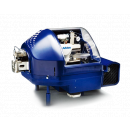应用领域:
资料类型:PDF
J Biol Chem. 2009 Nov 20;284(47):32493-506. doi: 10.1074/jbc.M109.014803. Epub 2009 Sep 18. Asparagine-linked oligosaccharides present on a non-consensus amino acid sequence in the CH1 domain of human antibodies. Valliere-Douglass JF1, Kodama P, Mujacic M, Brady LJ, Wang W, Wallace A, Yan B, Reddy P, Treuheit MJ, Balland A. Author information Abstract
We report that N-linked oligosaccharide structures can be present on an asparagine residue not adhering to the consensus site motif NX(S/T), where X is not proline, described in the literature. We have observed oligosaccharides on a non-consensus asparaginyl residue in the C(H)1 constant domain of IgG1 and IgG2 antibodies. The initial findings were obtained from characterization of charge variant populations evident in a recombinant human antibody of the IgG2 subclass. HPLC-MS results indicated that cation-exchange chromatography acidic variant populations were enriched in antibody with a second glycosylation site, in addition to the well documented canonical glycosylation site located in the C(H)2 domain. Subsequent tryptic and chymotryptic peptide map data indicated that the second glycosylation site was associated with the amino acid sequence TVSWN(162)SGAL in the C(H)1 domain of the antibody. This highly atypical modification is present at levels of 0.5-2.0% on most of the recombinant antibodies that have been tested and has also been observed in IgG1 antibodies derived from human donors. Site-directed mutagenesis of the C(H)1 domain sequence in a recombinant-human IgG1 antibody resulted in an increase in non-consensus glycosylation to 3.15%, a greater than 4-fold increase over the level observed in the wild type, by changing the -1 and +1 amino acids relative to the asparagine residue at position 162. We believe that further understanding of the phenomenon of non-consensus glycosylation can be used to gain fundamental insights into the fidelity of the cellular glycosylation machinery.
The unmodified NSGAL peptide and the glycosylated NSGAL peptide were observed eluting at 13 and 20 min, respectively, and were collected for further CID-MS/MS analysis by static nanospray infusion using a Triversa Nanomate (Advion Biosciences, Ithaca, NY, USA).




